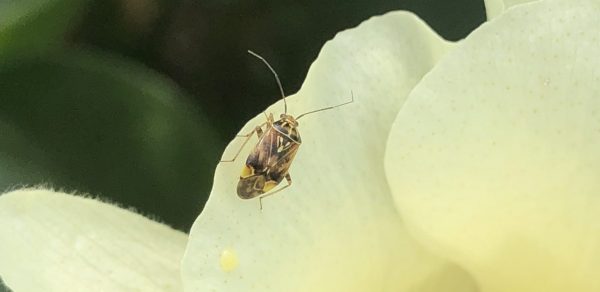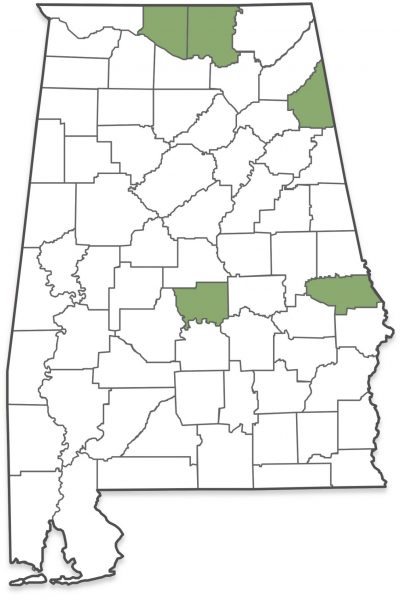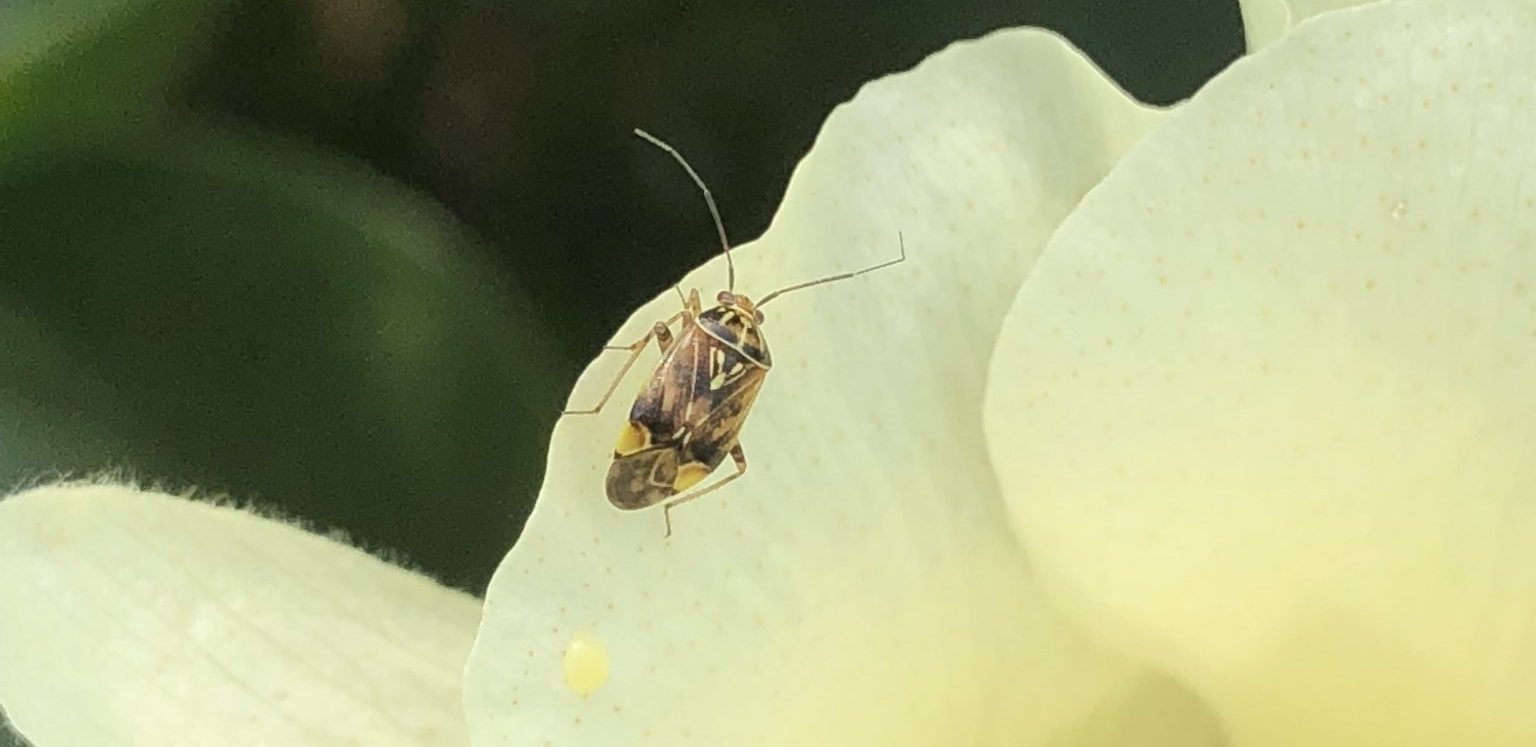Farming

Mitigating tarnished plant bug insecticide resistance requires an insecticide resistance management plan used in conjunction with solid integrated pest management strategies.

Figure 1. Adult tarnished plant bug.
The tarnished plant bug, Lygus lineolaris, is one of the key insect pests across much of the Cotton Belt. This pest is notorious in the Mid-South for its resistance to nearly every insecticide used for controls. In Alabama, few control issues have been reported or observed outside of the Tennessee Valley region of north Alabama, where pyrethroids consistently provide poor control.
In 2018 and 2019, Alabama Extension entomologists collected adult tarnished plant bugs as part of a regional project to screen for insecticide resistance. The findings can help cotton producers develop an effective insecticide resistance management (IRM) plan for their field operations.
Tarnished Plant Bug Collection Process
In June 2018 and 2019, adult tarnished plant bugs (figure 1) were collected from wild hosts (primarily daisy fleabane) using sweep nets. In 2018, they were collected from Madison County (Madison), Cherokee County (Centre), Lee County (Auburn), and Autauga County (Prattville). In 2019, bugs were collected in Limestone County (Mooresville), Cherokee County (Centre), and Lee County (Auburn). See table 1 and figure 2.
Collected plant bugs were allowed an observational period (at least 24 hours) and fed a diet of green beans to ensure that only healthy individuals were tested. To compare the feral populations with plant bugs that had never been subjected to insecticides, a laboratory colony from Mississippi State University was used as a check.
Table 1. Adult Tarnished Plant Bugs Collected in Alabama for Screening of Insecticide Resistance
| Year | Location (County) | Acephate (Orthene) | Bifenthrin | Sulfoxaflor (Transform) | Thiamethoxam |
|---|---|---|---|---|---|
| 2018 | Madison (Madison) | X | X | X | X |
| Centre (Cherokee) | X | X | |||
| Auburn (Lee) | X | X | X | ||
| Prattville (Autauga) | X | X | X | ||
| 2019 | Mooresville (Limestone) | X | X | X | X |
| Centre (Cherokee) | X | X | X | ||
| Auburn (Lee) | X | X | X | X |
Resistance Trials (Bioassays)

Figure 2. Counties (where tarnished plant bugs were collected to screen for insecticide resistance in 2018 and 2019.
To determine plant bug susceptibility to tested insecticides, laboratory bioassays were conducted based on the type of insecticide used (contact versus systemic).
For contact insecticides (acephate and bifenthrin), testing was done using a method called surface contact toxicity assays. Two adult plant bugs were placed in 20-milliliter vials treated with eight concentrations (rates) of each insecticide. Bugs were left in the vials with a green bean pod food source for 24 hours and then rated for mortality (death).
Systemic insecticides (thiamethoxam and sulfoxaflor) were tested using oral toxicity assays. Two plant bugs were placed into vials with OASIS floral plugs treated with eight concentrations of each insecticide. Bugs were left in vials for 48 hours and then rated for mortality. At least 100 healthy adult plant bugs (fifty vials) were tested for each insecticide, with ten or more bugs tested with each insecticide concentration.
To understand the difference between the lab colony and feral populations, the lethal concentration 50 (LC50) of each was determined. The LC50 is the amount of insecticide needed to kill 50 percent of the tested population. More susceptible populations have a lower LC50 as less insecticide is needed to kill individuals.
After determining the LC50 for each population and insecticide, the resistance ratio 50 (RR50) could be determined. The RR50 is calculated by dividing the LC50 of the test population by the LC50 of the susceptible (lab) population. The populations are then classified as having low (RR50 less than or equal to 3), medium (RR50 less than or equal to 10), or high (RR50 greater than 10) levels of resistance. For example, if the LC50 of a population collected in Auburn is 0.18 μg vial-1, and the lab population LC50 to the same insecticide is 0.05 μg vial-1, the RR50 would be 3.6 (0.18 ÷ 0.05). The higher the RR50, the more resistant the population is to the insecticide.
Table 2. Results of Bioassays Conducted on Adult Tarnished Plant Bugs in Alabama
2 Resistance ratios (RR50) rate as low (l): ≤ 3; medium (m): ≤ 10; or high (h): > 10
| Year | Insecticide | Location (County)1 | N (No. TPB) | LC50 | RR502 |
|---|---|---|---|---|---|
| 2018 | Acephate | MSU (lab) | 140 | 2.29 | - |
| Acephate | Madison (Madison) | 260 | 10.30 | 4.50 (m) | |
| Bifenthrin | MSU (lab) | 200 | 0.05 | - | |
| Bifenthrin | Auburn (Lee) | 100 | 0.02 | 0.40 (l) | |
| Bifenthrin | Centre (Cherokee) | 100 | 0.38 | 8.07 (m) | |
| Bifenthrin | Madison (Madison) | 200 | 0.10 | 2.15 (l) | |
| Bifenthrin | Prattville (Autauga) | 100 | 0.29 | 6.27 (m) | |
| Sulfoxaflor | MSU (lab) | 140 | 0.17 | - | |
| Sulfoxaflor | Auburn (Lee) | 100 | 0.06 | 0.35 (I) | |
| Sulfoxaflor | Madison (Madison) | 100 | 0.23 | 1.32 (l) | |
| Sulfoxaflor | Prattville (Autauga) | 100 | 0.19 | 1.11 (I) | |
| Thiamethoxam | MSU (lab) | 100 | 0.14 | - | |
| Thiamethoxam | Auburn (Lee) | 100 | 0.22 | 1.57 (I) | |
| Thiamethoxam | Centre (Cherokee) | 110 | 0.05 | 0.36 (l) | |
| Thiamethoxam | Madison (Madison) | 200 | 0.04 | 0.29 (I) | |
| Thiamethoxam | Prattville (Autauga) | 180 | 0.03 | 0.21 (l) | |
| 2019 | Acephate | Auburn (Lee) | 200 | 1.42 | 0.62 (I) |
| Acephate | Centre (Cherokee) | 100 | 7.69 | 3.36 (m) | |
| Acephate | Mooresville (Limestone) | 100 | 7.30 | 3.19 (m) | |
| Bifenthrin | Auburn (Lee) | 200 | 0.18 | 3.83 (m) | |
| Bifenthrin | Centre (Cherokee) | 200 | 0.64 | 13.62 (h) | |
| Bifenthrin | Mooresville (Limestone) | 200 | 1.30 | 27.66 (h) | |
| Sulfoxaflor | Auburn (Lee) | 200 | 0.25 | 1.46 (I) | |
| Sulfoxaflor | Centre (Cherokee) | 100 | 0.23 | 1.36 (l) | |
| Sulfoxaflor | Mooresville (Limestone) | 100 | 0.21 | 1.21 (I) | |
| Thiamethoxam | Auburn (Lee) | 200 | 0.04 | 0.29 (l) | |
| Thiamethoxam | Mooresville (Limestone) | 100 | 0.12 | 0.86 (l) |
Results
In general, adult tarnished plant bugs were more difficult to control with acephate and bifenthrin in north Alabama (Limestone, Madison, and Cherokee Counties) than in central Alabama (Lee and Autauga Counties) (table 2). This reflects the experiences of Alabama Extension entomologists, who have noted poor performance from pyrethroids and a need to increase rates of acephate to get adequate control in north Alabama.
Interestingly, the Limestone County population in 2018 showed low resistance levels (2.15) to bifenthrin (table 2). While this may be explained by natural variation of early-season populations, it is unlikely that this is an accurate representation of populations in the area. This is reflected by the Madison County population in 2019, whose bifenthrin resistance level (27.66) was the highest of any populations or insecticides tested.
Resistance ratios for sulfoxaflor and thiamethoxam were low (less than 3) for all populations tested (table 2). This is not surprising for sulfoxaflor (Transform WG) as it is a relatively new chemistry (label approved in 2013). The low resistance levels of thiamethoxam (Centric 40WG) are likely due to the insecticide’s use patterns. Both of these products have activity on a relatively low pest spectrum (e.g., plant bugs, aphids) and are not used later in the season when sprays are also targeting stink bugs and/or bollworms. Thus, an unintended insecticide resistance management strategy is used for these products.
Resistance Management
To mitigate tarnished plant bug insecticide resistance and preserve current chemistries, an insecticide resistance management (IRM) plan must be followed. A proper IRM plan follows along with solid integrated pest management strategies. These include proper scouting and only treating when populations reach economic thresholds. Automatic or prophylactic insecticide applications should be avoided so that populations are not exposed unnecessarily to resistance selection.
Tank mixing and/or rotating insecticide modes of action (MoA) also play a critical role in IRM. For example, if a neonicotinoid (IRAC Group 4A) insecticide (e.g., imidacloprid) is sprayed for plant bugs on squaring cotton in June, a different MoA should be used for the next treatment if needed. Depending on location in the state, this could include a pyrethroid (IRAC Group 3A) such as bifenthrin or an organophosphate (IRAC Group 1B) such as dicrotophos (Bidrin 8).
Alternating insecticides helps to ensure that plant bugs or offspring of plant bugs that survived the neonicotinoid insecticide are not selected for resistance a second time in the same season. Switching from one pyrethroid to another (e.g., lambda-cyhalothrin to bifenthrin) does not help with IRM, as these chemicals exert toxic effects in the same way.
For more information on insecticide modes of action, visit the Insecticide Resistance Action Committee (IRAC) website. For up-to-date thresholds, insecticide recommendations, and insecticide efficacy ratings, see the Cotton IPM Guide (Extension publication IPM-0415).
Resources
Dorman, S. J., Gross, A. D., Musser, F. R., Catchot, B. D., Smith, R. H., Reisig, D. D., Reay-Jones, F. P., Greene, J. K., Roberts, P. M. and Taylor, S. V., 2020. Resistance monitoring to four insecticides and mechanisms of resistance in Lygus lineolaris Palisot de Beauvois (Hemiptera: Miridae) populations of southeastern USA cotton. Pest Management Science. 76: 3935-3944.
 Scott H. Graham, Extension Specialist, Assistant Professor, Entomology and Plant Pathology, Auburn University
Scott H. Graham, Extension Specialist, Assistant Professor, Entomology and Plant Pathology, Auburn University
New August 2021, Tarnished Plant Bug Resistance in Alabama, ANR-2788

